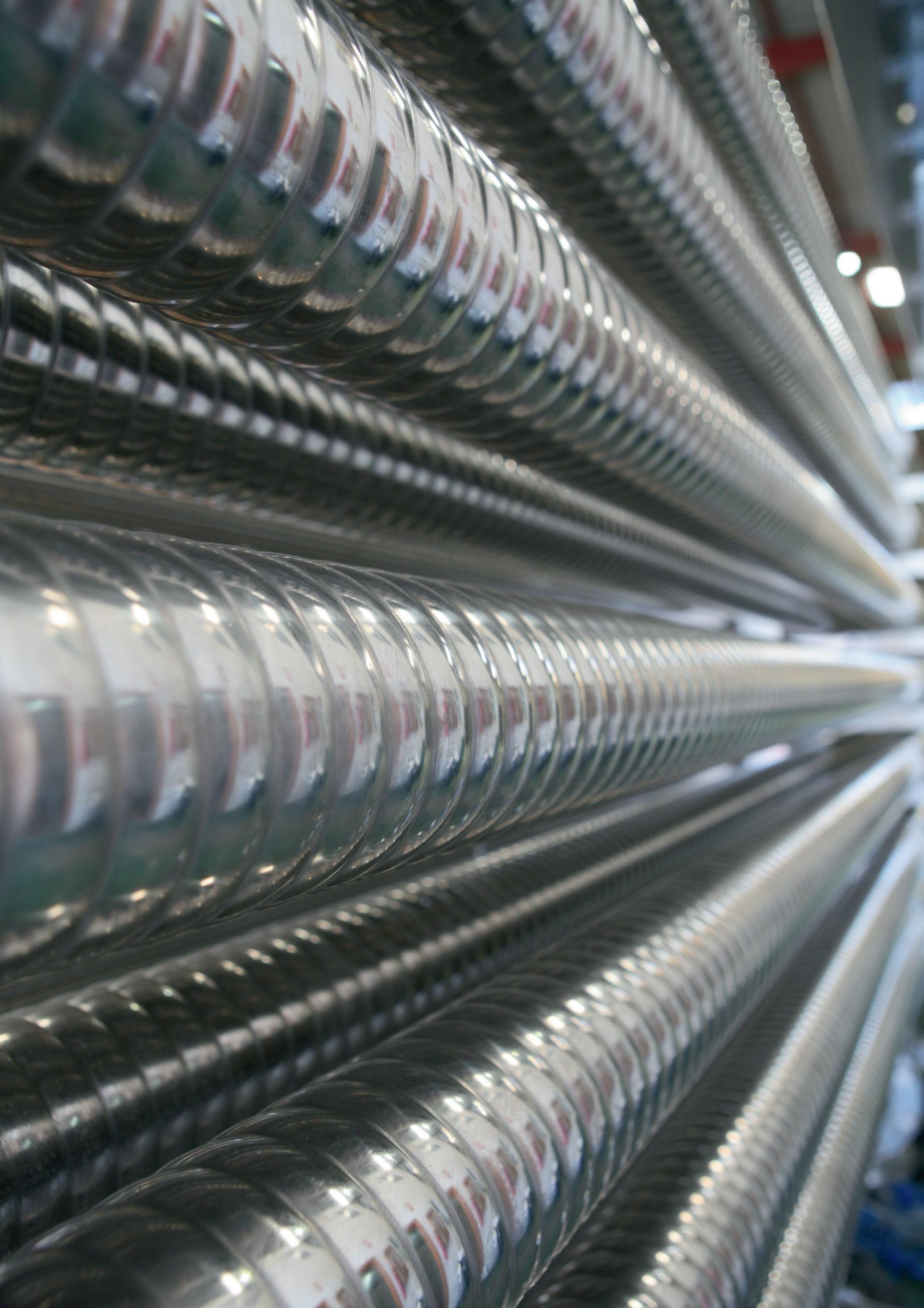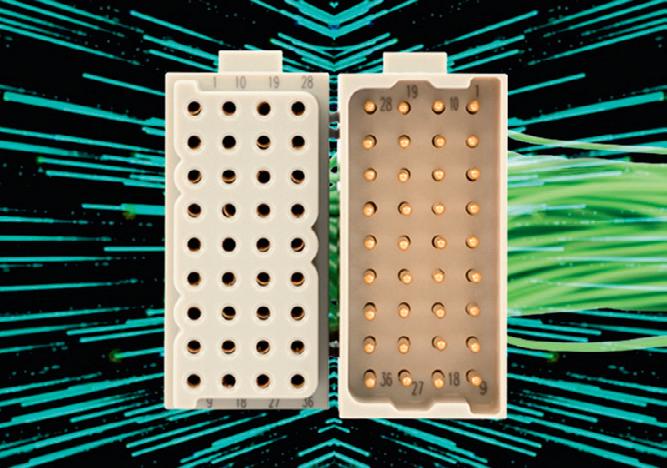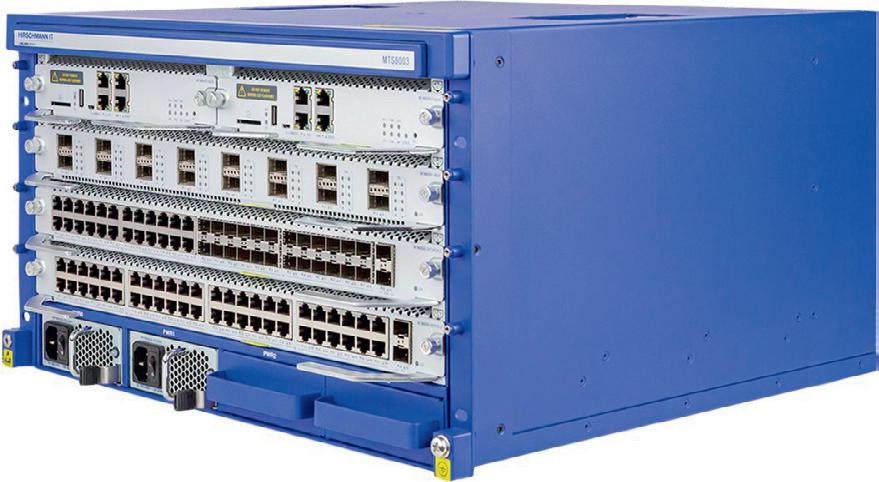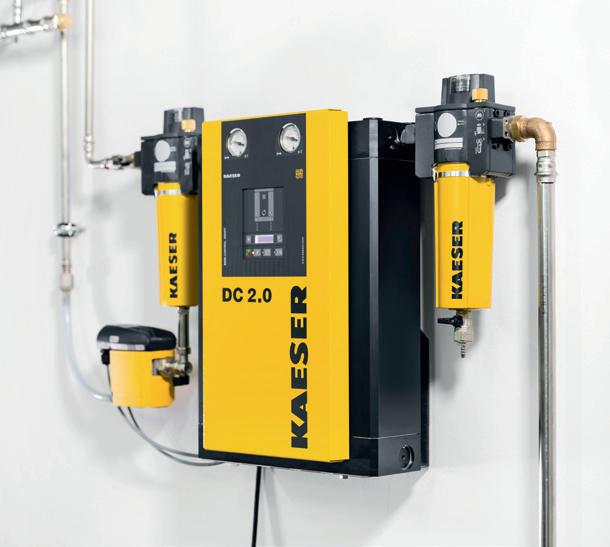
16 minute read
Choosing the right heat exchanger for wastewater applications
CHOOSING THE RIGHT HEAT EXCHANGER FOR WASTEWATER APPLICATIONS Matt Hale, International Sales & Marketing Director, HRS Heat Exchangers
Heat exchangers are crucial to many processes in the water industry, whether as part of an aerobic or anaerobic digestion plant, for cooling or evaporation, and for sludge concentration. There are several different types of heat exchanger available and choosing the right one can appear daunting. For both economic and environmental reasons, maximising productivity is essential for companies to remain competitive, and correct heat exchanger selection is key to this, as is maximising the use of all outputs, including power and digestate produced through anaerobic digestion (AD).
What is productivity? Productivity is measured by the ratio of output per unit of input. Many water companies see it as a balancing act: how can they increase their output without increasing their costs? It is intricately linked to efficiency, ensuring that every piece of equipment and every part of the process is optimised, delivering greater value for money to the operator.
Due to the pressures on water availability, Australia already has some of the most effective water treatment infrastructure in the world, and many areas are following Perth in considering the ‘direct potable reuse’ of treated sewage in the water supply. There is real potential to increase the efficiency of existing AD plants, not least because some of the oldest wastewater AD facilities are now able to upgrade and take advantage of the latest technology.
The potential of such upgrades is illustrated by the 163 wastewater AD plants in the United Kingdom, which account for around 28% of the country’s total AD capacity. Thanks to project upgrades and efficiency improvements, the UK AD sector delivered a 25% increase in power production from just a 12% increase in capacity between 2010 and 2015.
Understanding the process The most important criterion when specifying a heat exchanger is to ensure that it will be fit for purpose. To do this, it is important to understand the material being treated, the heating (or cooling) medium and the process involved. Is the material in question liquid (dirty or clean water) or semi-solid (sludge or digestate)? Is it viscous? What is the extent of the temperature difference required? Is there the option to use a source of hot or cold water from another part of the plant, and will heat regeneration technology help to improve overall energy efficiency?
Other information must also be provided for correct heat exchanger selection. For example, does the product contain solid particles? Consider also whether it is shear sensitive, if the process needs a scraped surface heat exchanger (SSHE) or whether corrugated tubes will be enough to prevent fouling. Also bear in mind the space available for the heat exchanger, and the connection pipework and fittings. The more information an operator can provide, the more likely they are to get the right heat exchanger for the job.
Avoiding a false economy After thoroughly researching the options available it may be that more than one type or model of heat exchanger is suitable for the purpose. To ensure optimum productivity, it is important to consider the total cost of ownership (TCO). Although some operators can be swayed by the initial purchase price, this can be a false economy. The lifecycle cost of a heat exchanger — particularly one used to process difficult materials such as sewage sludges — heavily depends on the costs of cleaning and maintenance. Buying a cheaper design that is more prone to fouling can quickly become more expensive to operate. To keep productivity high, it is therefore essential to consider the TCO of a heat exchanger, not just the purchase price.
Energy efficiency The running costs of a heat exchanger also have a large effect on its overall financial viability, so selecting a heat exchanger that is energy efficient is key to enhancing productivity. Some heat exchangers have features specifically designed to improve the operational energy efficiency.
Scraped-surface heat exchangers also minimise potential fouling by keeping the tube wall clean and create turbulence within the material. Both actions help to increase heat transfer rates, and together they create a highly efficient heat transfer process ideal for high-fouling viscous materials like sludges.
Recapturing heat is also one of the easiest ways to improve efficiency, and heat exchangers represent the best way of doing this. They are an established technology, but despite their widespread use in industries such as food manufacturing and the chemical sector, they are often under-used in wastewater AD plants.
Making the most of heat Surplus heat can be recovered for use in the AD process itself, for example to pre-heat feedstock or digesters to improve gas production efficiency; for water treatment, pasteurisation and concentration processes; to heat offices or for space heating; or to provide hot water for cleaning. Using surplus heat is also free, without the need to buy additional fuel, and all of these applications can be carried out using a suitable heat exchanger — a well-designed system could recover and utilise 40% of the heat produced by the plant.
Furthermore, heat exchangers can be used to pasteurise digestate (the biofertiliser left over at the end of the AD process) and are more efficient than using tanks with heating jackets, as they have a much lower heat requirement. Using heat exchangers means that effective digestate pasteurisation is possible using surplus heat, rather than needing to install an additional heat source such as a biomass boiler, which could add hundreds of thousands of dollars to a project. The right system can also provide a continuous pasteurisation process, using less energy than alternative systems, while allowing additional thermal regeneration levels of up to 60%. This saved heat can then be used elsewhere, such as an evaporation plant.
Heat can also be used to separate water from digestate by concentration. This technique can reduce the overall quantity of digestate by as much as 80%, greatly lowering the transport costs associated with the removal of digestate. A well-designed concentration system will include measures to retain the valuable nutrients in the digestate, while the evaporated water can be condensed and reused. For example, the captured water can be added back to the feedstock as it enters the digester, making the entire process almost self-sufficient in terms of water use and

eliminating liquid discharges from the plant. After concentration, the treated digestate dry solid content can be as much as 20% (often a fourfold improvement), making it much easier to transport and handle.
Maintenance matters Using the wrong heat exchanger can soon prove costly in terms of maintenance and spare part costs. In fact, in some cases it becomes necessary to replace entire heat exchangers when they have become too expensive to clean and maintain, something commonly seen in the wastewater sector. It is therefore important to make sure that heat exchangers are designed to make cleaning and maintenance as easy and flexible as possible, while reducing cleaning and maintenance intervals.
Choosing equipment that can be remotely monitored also makes it easier to anticipate problems, enabling predictive maintenance with the help of the manufacturer. Being able to quickly identify issues helps to keep efficiency high and provides more time to plan for maintenance, resulting in less downtime for operators.
Beware hidden costs Another consideration is the overall installation cost, and whether fitting the heat exchanger will require the purchase of ancillary equipment. Corrugated tube-in-tube heat exchangers result in improved efficiencies, providing comparable thermal performance to other designs, but in a smaller footprint. These can often be skid- or frame-mounted, reducing the need for significant support infrastructure.
A balancing act While a low purchase price may appear attractive, much of the TCO comes from running costs, and keeping these lower over the lifetime of the heat exchanger will provide a greater return on investment in the long run. Whatever solution you choose, make sure to consider its energy efficiency, maintenance requirements and the costs of any ancillary equipment before signing on the dotted line. Put simply, specifying the wrong heat exchanger could decrease your productivity — choosing the right heat exchanger will almost certainly increase it.

ROBOTIC CONTROLLER The ADLINK ROScube-I Series is a ROS 2-enabled robotic controller based on Intel Xeon E, 9th Gen Intel Core i7/i3 and 8th Gen Intel Core i5 processors, and features broad I/O connectivity supporting a wide variety of sensors and actuators to meet the needs of a wide range of robotic applications. It also supports an extension box for convenient functional and performance expansion with Intel VPU cards and the Intel Distribution of OpenVINO toolkit for computation of AI algorithms and inference. Robotic systems based on the ROScube-I are supported by ADLINK’s Neuron SDK, a platform specifically designed for the professional robotic applications such as autonomous mobile robots (AMR). The ROScube-I series also features real-time middleware for communication between software components and devices, a hypervisor for safe mission-critical mission execution, ruggedised, secure connectivity with locking USB ports and the option of an RTOS such as VxWorks. Also available for developers are the ROScube-I Starter Kit or ROScube Pico Development Kit to rapidly prototype algorithms and immediately deploy them to ADLINK’s NeuronBot ROS 2-based rapid robotic development kit for demonstration. This allows for fast improvement of AI models and acquisition of vision data to optimise operational decision-making. The NeuronBot also supports ADLINK’s Neuron SDK.
ADLINK Technology Inc
www.adlinktech.com


Your Global Automation Partner
MODULAR CRIMP INSERT The ILME MIXO series of modular connector units has been updated with the addition of the CX 36 IF/M crimp insert, a solution designed for the automation industry and focused on signal transmission scope.
With a rating of 4 A, 32 V with its 36 poles in a single module, the product features a high contact density that allows the user to save mounting space and to employ it flexibly in multiple applications. Used in combination with other MIXO modules, it aids in the efficient installation of robots and other machine implementations.
The wide range of crimp contacts, such as turned or stamped gold plated, silver plated or the specially treated HNM contacts for up to 10,000 matings (along with special frames), enlarges the installation possibilities.
Treotham Automation Pty Ltd
www.treotham.com.au
ETHERNET SWITCHES The Hirschmann Mammuthus or MTS series high-performance Ethernet switches are designed to offer an intelligent and secure IT/OT converged solution for a range of networks across many industries to maximise performance.
The series features advanced Layer 3 functionality to support flexible redundancy technology and comprehensive security solutions. In addition, IT networking technology is available with the option of PoE, PoE+, Stack MPLS, ERPS, Storm control and IPv6, and can be used in conjunction with Hirschmann’s existing range of industrial Ethernet switches to provide an end-to-end solution that can be managed simultaneously by Industrial HiVision.
The range is suitable for applications in industrial IT networks, smart buildings and CCTV.
Control Logic Pty Ltd
www.controllogic.com.au

Get More Reliable Detection of Valves in Processing Applications

Choose rugged inductive sensors to more reliably monitor the position of valve handles on tanks and containers during processing applications. Actuated valves receive control signals from sensors and other devices to enable more efficient processing. With an assortment of potential mixtures, it is important to use sensors that are accurate, can optimize machine efficiency and stand up to harsh cleaning.
Wash-down rated Uprox Inductive sensors from Turck are ideal for liquid processing lines, in filling functions, or other types of food processing machinery to detect metal valves. Plus, IO-Link makes remote monitoring easy.
Contact your local Turck sales representative to learn more.
www.turck.com.au 1300-132-566
HIGH VOLTAGE DAQ MODULES KRYPTON data acquisition modules are designed to be small, rugged and modular, especially made for field measurements in any environment. The small size of KRYPTON modules allows them to fit in tight places and they can be placed close to the sensors. The latest addition to the KRYPTON ONE range are two modules made for high voltage and thermocouple temperature measurements with high isolation: the KRYPTONi-1xHV and the KRYPTONi-1xTH-HV. Both DAQ modules provide safety at high voltages with an overvoltage category CATII 1000V. The KRYPTONi-1xHV module is designed for high voltage measurements with a single input range of ±1000 V. The acquisition is based on a 24-bit SAR ADC with a sampling rate of up to 40 kS/s and an additional anti-aliasing filter. The input connector is a 4 mm safety banana jack.
The KRYPTONi-1xTH-HV is an isolated single thermocouple module designed for temperature measurements at high voltages, and supports a K-type thermocouple. Temperature is acquired by using a 24-bit delta-sigma ADC with the sampling rate up to 100 S/s. Cold junction compensation is provided by a Pt1000 sensing element. The input connector, LEMO Redel 2P series, is designed in plastic to enable sufficient isolation and clearances.
Bringing the data acquisition systems closer to the sensor greatly reduces the cost of the sensor cabling and the chance of wiring errors while improving the signal quality.
Metromatics Pty Ltd
www.metromatics.com.au

DESICCANT AIR DRYERS The DC series of desiccant dryers from Kaeser Compressors can lower the pressure dewpoint of the compressed air to -70°C. The company says they combine high energy efficiency and low maintenance costs, delivering frost protection for control valves and lines while producing dry compressed air for sensitive processes at a lower cost.
The DC 2.0 to 11.3 models can operate in, for example, 10 min cycles to achieve pressure dewpoints down to -40°C. During this process, the dryer switches between the two desiccant chambers only once every 5 min. This dramatically reduces the number of switching sequences between the chambers and resulting material wear on the valves and desiccant.
Long cycle times additionally reduce the amount of compressed air required to restore pressure following the desiccant regeneration phase. As an example, whereas 7.6% of the compressed air must be diverted for a 2 min cycle, this proportion falls to 1.3% with the 10 min cycle of the small DC units. This reduction makes them more efficient, saving energy and extending desiccant service life.
On/off control of the DC 2.0 to 11.3 series models allows for intermittent operation, which saves energy when there is frequent interruption of duty cycles. This employs ‘reverse regeneration’, where the regeneration cycle always uses up air from the downstream air receiver. A completely regenerated desiccant chamber is therefore always available each time the drying cycle restarts.
Kaeser Compressors Australia
au.kaeser.com


IO-LINK I/O HUB Pepperl+Fuchs has released an I/O hub with IO-Link interface that enables easy and efficient integration of binary sensors and actuators into the IO-Link communication channel. The hub offers eight ports with 16 digital inputs. In combination with the Ethernet I/O module with integrated IO-Link the device forwards up to 128 digital I/Os to higher-level control systems. Since only one connection cable is required for signal transmission and power supply, the cabling effort is reduced considerably.
With a robust, fully encapsulated metal housing and a wide temperature range of -25 to +70°C, the IP67 rated I/O hub can also be used in demanding industrial environments.
The housing is compact and features clearly visible LEDs that indicate operation, switching status or possible errors. The slim solution reduces cabling complexity and minimises wiring errors, as it requires only one connection for signal transmission and power supply. It also allows a mixture of IO-Link sensors and common binary sensors in one set-up, freeing users from technological restrictions.
© Stock.Adobe.com/au/Dusko
AUTOMATED INSPECTION OF GLASS BOTTLES USING A PROFILE SCANNER

The scanCONTROL laser profi le scanner from Micro-Epsilon can be used in factory automation applications such as presence monitoring systems. Typical uses have previously been the detection of the empty containers at bottlers and breweries. A system based on the laser triangulation principle is installed for carrying out this presence monitoring operation, which is used when the bottle crates are received.
In a brewery or bottler, the main challenge with performing measurements on glass bottles is the refl ective properties of the bottles. These properties vary due to different glass colours — such as green and brown — and also because bottles come with or without a lid. Performing measurements on bottles can also be very difficult due to the constant vibration and shaking of the bottles while they are being transported on the conveyor belt. The scanCONTROL 2900-50 offers a real-time surface compensation feature in which the exposure time and the threshold of refl ection detection are adapted in real time in order to generate stable measurement results.
The scanCONTROL 2900-50 laser scanner features a special line-scanning optical system that ensures a uniform exposure of the measuring fi eld. It operates according to the principle of optical triangulation. A laser light is projected onto the target surface via a linear optical system — the diffuse refl ected light from the laser line is then replicated on a sensor array by a high-quality optical system, which then evaluates the image in two dimensions. It offers precision measurement even in harsh environments.
Bottle inspection
Crates with empty bottles are sent for inspection to determine whether the correct type of bottle is in the crate, if the height of the bottles is appropriate and if any bottle is missing from the crate. To perform this automated inspection, the inline monitoring system is equipped with fi ve scanCONTROL 2900-50 laser line triangulation sensors, and the crates on the conveyor belt are scanned from above. The laser scanners are located in such a way that each scanner measures a row of bottles in the crates. The monitoring is carried out at speeds of up to 850 mm/s. The scanners measure the height of the bottles in the crate based to detect any that are not fi tted correctly. While doing so, they ensure that the height of the bottles does not deviate more than 3 mm from the target height for the respective bottle type.
In addition to the high-speed measurement, the system also provides access to logged data for subsequent statistics, evaluation and process optimisation. The measured values are evaluated directly inline via a GigE Vision interface that integrates the raw data into the image processing software and then further evaluates it. The fi nal result of the presence monitoring is received by PLC as an ‘OK’ or ‘not OK’ value, whereby any faulty crates can be removed directly. The results can also be displayed via an integrated display on the control unit.
Other factory automation applications
Automated inspection has become particularly important in production lines in the manufacturing of steel, plastic, fabric, paper, coated board, chip packaging and the food and beverages industries. The typical applications of laser profi le scanners in factory automation are in measuring diameter, thickness profi les, and edge defects of pizzas, measuring the size and weight of biscuits, inspecting labels on cans, assessment of fruits, vegetables, cheese, noodles and meat. The scanCONTROL laser scanners are available in different laser types and with a comprehensive range of accessories so that numerous measurement tasks can be solved for different industries.







